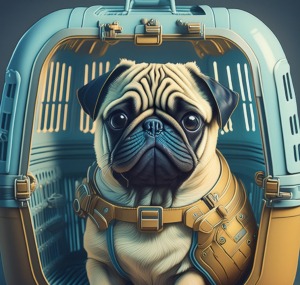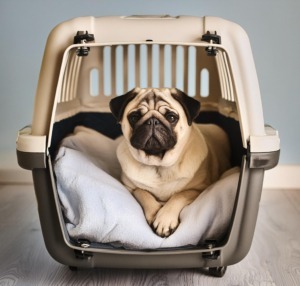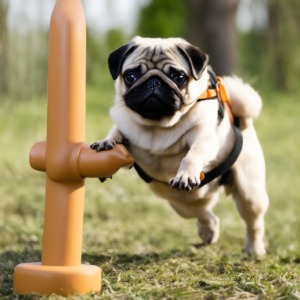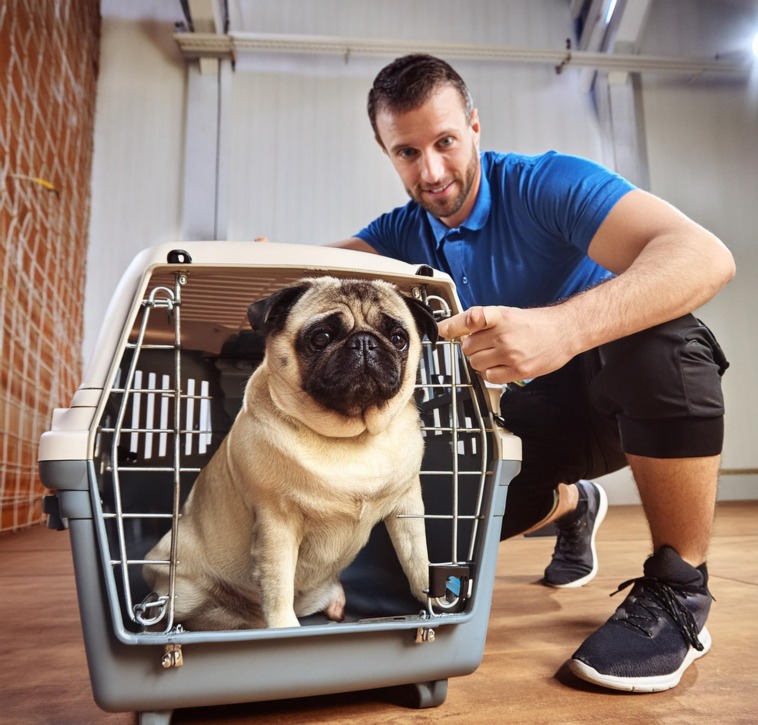Last updated on October 24th, 2024
Here’s an overview:
Crate Training Your Pug: An Introduction
Understanding The Pug’s Personality For Effective Training
Choosing The Right Crate For Your Pug’s Size And Needs
Step By Step: Introducing Your Pug To The Crate
The Importance of Comfort: Creating a Positive Space out of the Crate
Crate Training Schedule for Your Pug
Addressing Common Pug Crate Training Challenges
What Not to Do: Common Crate Training Mistakes to Avoid
Crate Training While You’re Away: Building Up to Longer Periods
Consistency with Routine Maintenance of Crate Training
Making Crate Training Part of Your Pugs Lifestyle
Conclusion: The Benefits of Patience and Perseverance in Crate Training
Crate Training Your Pug: An Introduction
Crate training is one of the most important things you can do when raising a well-rounded pug puppy. It provides them with their safe space and helps establish routines such as housebreaking or managing behavior. A crate is like a den that dogs naturally want to have because it gives them protection and territory. At first glance, crate training may seem restrictive but it actually makes Pugs feel more secure if done right. This process will take time so be patient with your furry friend!
Understanding The Pug’s Personality For Effective Training
Pugs have some unique traits that affect how they are trained due to their personalities being very different from other breeds; knowing these characteristics will streamline the process of crate training:
- Social: Pugs love people and can get separation anxiety so make sure crate time is positive not associated with loneliness.
- Stubbornness: They are smart yet stubborn which means consistent but gentle training methods are required for success.
- Playful: Utilize this quality by using games during crate training sessions.
- Sensitive: Harsh discipline does no good since pugs don’t respond well; use positive reinforcement instead.
- Food Motivated: Use treats sparingly as rewards for desired behaviors shown by your pug while avoiding overfeeding him/her at any given point in time.

Knowing these things will help you come up with an effective strategy for crate training your pug pup!
Choosing The Right Crate For Your Pug’s Size And Needs
Pugs are small dogs so choosing the right size crate is crucial; they need enough space inside to stand up fully, turn around easily, stretch out comfortably etc.; typically crates should be between 24 inches – 30 Inches in length as this allows them enough room for all their activities without feeling cramped or restricted at any point in time. Also ensure there’s proper ventilation on whichever type of cage you settle upon especially considering respiratory problems common among puggles. The material used should be strong enough to withstand some chewing since puppies have a tendency of trying to test everything with their teeth; you might also want to get one that comes with a divider for growth purposes.
Step By Step: Introducing Your Pug To The Crate
-
Start off by getting the right-sized crate:
This means it should not be too small or constricted but rather spacious enough for them stand up fully, turn around easily and lie down comfortably even if they grow bigger in future; otherwise this could lead into creating another bathroom area where they sleep which is quite unpleasant both on our parts as pet owners and theirs too since nobody likes sleeping next to his/her own mess.
-
Introduce it gradually:
Begin placing their new home within reach like say in living room then give him sometime alone while keeping door open before encouraging exploration using treats/toys placed inside attractively near entrance thus enabling him find out more about its features without being forced upon anything at all.
-
Feed meals near there:
Initially start off by placing food dish just beside cage opening but eventually shift dish right inside making sure such changeover creates positive association between eating meals being confined within that same space which becomes his new abode henceforth.
-
Use comforting items:
You could add soft blanket or shirt having your scent on it so that he feels more secure when wrapped up against cold drafts around him especially during winter season thereby resembling mother’s warmth during nursing periods; however avoid putting any hard objects lest they pose danger during playful moments while still unfamiliarized themselves entirely with surroundings therein including corners.
-
Engage them in games related to crates:
I don’t know if you’ve ever tried playing hide & seek game but let me tell ya this will work wonders with pugs as well since they are very playful creatures who love exploring new environments around them.
-
Implement short crating periods within presence:
Start off with short intervals whereby u crate him for few minutes before letting him come out again while still remaining close-by thus allowing him/her see that it’s not abandonment but rather a necessary part of training process.
-
Never use crate as punishment:
It is absolutely crucial never ever to employ these types of facilities when punishing your beloved friend irrespective whether inside house or outside enclosure provided for them.
The Importance of Comfort: Creating a Positive Space out of the Crate
It is important to ensure that a pug puppy associates its crate with comfort and security. Here are some things to consider:
- Soft Bedding: Provide a cozy blanket or soft bed for the inside of the crate.
- Familiar Scents: Use an item of clothing or toy that smells like the owner, as this can be comforting.
- Entertainment: Give chew toys to keep them stimulated and help with any anxiety they may have.
- Positive Association: Always make sure that the crate is linked with positive experiences such as treats or praise.
- Consistent Routine: Establishing a regular routine for crating will help reinforce its role as a safe space for them.
By focusing on comfort, owners increase their chances of success in quickly and positively training their pug puppy to use a crate.
Crate Training Schedule for Your Pug
When starting out with crate training your Pug puppy, one thing you need to do is create an established schedule. This will help give them security knowing what comes next each day. Begin with 10-15 minutes intervals and gradually increase duration as your Pug gets comfortable staying inside it.
A sample schedule includes:
- Morning: Immediately after waking up let your Pug go outside bathroom area then play around before having 20-minute crating session while you prepare yourself for work/school/etc..
- Midday: Take them outside again after meal times followed by placing into the crate so they can nap anywhere from 30 minutes all the way up till 2 hours depending on how tired they are feeling at that moment in time.
- Evening: Another crate stint post-evening meal & potty trip could serve well as wind down before bedtime routine begins kicking in fully swing mode throughout restful night sleep period ahead.
- Nighttime: Make sure their crate is comfy enough for overnight sleeping purposes with necessary potty breaks provided when needed.

Remember to praise and reward your Pug when it utilizes the crate correctly so that positive associations are made.
Addressing Common Pug Crate Training Challenges
There are several common challenges that often arise when crate training pugs:
Resistance & Whining: Because of separation anxiety, pugs tend to resist crates initially. Make it welcoming by using comfortable bedding along with familiar toys inside. Gradually increase hours spent within while you’re still at home alone during daytime hours away from them due to work/school/etcetera obligations.
Accidents in the Crate: Should an accident occur within its confines; too much time may have been spent there or perhaps a medical condition exists which requires veterinary attention be sought immediately without any delay whatsoever.
Chewing on the Crate: Provide chew toys for entertainment purposes thereby deterring boredom related chewing behaviors from manifesting themselves further into reality such as destroying parts of the cage bars etcetera over extended periods left unattended unsupervised in this regard entirely.
Escape Attempts: Safeguard against harmful consequences brought about by escaping incidents where possible through ensuring proper closure mechanism employed throughout every single time access granted towards outside world barred off completely via appropriate secure fastening method adopted according to safety regulations governing same uniformly across all individuals tasked with handling pets confined therein under lock up key arrangement designed specifically for such purpose only limited accessible points involving opening enclosed area being allowed thus far beyond reach keen curious minds mulling over their next move closely monitoring each step taken towards realization goal set forth ever.
Patience gets rewarded: Realize that training takes time. Reward small progress towards longer stays.
What Not to Do: Common Mistakes to Avoid
When you are crate training your pug puppy, these are the mistakes that should be avoided for a positive experience:
- Forcing Your Pug into the Crate: This can make them anxious and create a negative association with the crate that may be hard to get over.
- Skipping Steps in Crate Training: Introduction should be gradual. Increase crate time slowly so as not to cause distress.
- Neglecting Comfort in the Crate: Make sure it is a safe place for them. Without comfortable bedding or occasional treats they might find it unwelcoming;
- Using the Crate as Punishment: Instead of viewing it as restful space this teaches them to fear and resent the crate.
- Leaving Your Pug Crated Too Long: Pugs are social animals and need regular interaction/exercise; extended periods confined can lead to anxiety/health problems.
Avoid these pitfalls for successful crate training with your pug puppy.
Crate Training While You’re Away: Building Up to Longer Periods
When you are teaching your pug puppy how to be comfortable in a crate while you’re away from home, gradually increasing their confinement time is important.Begin by confining them for short intervals (10-20 minutes) and slowly increase this duration as long as they remain calm/restful within its walls.
Consistency is key: Therefore if at any point during each step up of time extension signs of distress become apparent.
Consistency with Routine Maintenance
Being consistent and maintaining routine are very important factors when it comes to crate training your pug puppy. Here are some principles you should consider:
- Establish a regular schedule for feeding times, bathroom breaks, playtime sessions and crate time so that the puppy can feel safe and understand what is expected of them in each situation.
- Use consistent commands or cues while directing your pug into/out of a crate. Always reward such behavior with treats/praise;
- Increase hours spent inside gradually ensuring comfortability as well as avoiding creation of negative association between confinement periods and unpleasant experiences.
- Integrate crate time into different activities throughout the day for your pug; this will make it become part of their daily life rather than something occasional.
If you stick to these habits then soon enough crating will become second nature to your pet.

Making Crate Training Part of Your Pugs Lifestyle
To make crate training part of your pug’s everyday routine calls for patience and consistency. Begin by placing the crate in an area where people are often present so that they do not feel secluded.
Conclusion: The Benefits of Patience and Perseverance
Crate training a pug puppy requires time and determination, but it pays off. There’s a lot to be said for sticking with something — in this case, crate training — even when it gets tough. Some of the benefits are:
- Creating a safe space for the puppy which reduces anxiety and destructive behavior.
- Making toilet training easier because dogs don’t like to soil their dens.
- Establishing a routine that gives comfort through predictability.
- Building independence so that the pug is prepared for being left alone.
- Increasing safety while travelling or during emergencies.
Showing empathy throughout this process will result in a well-adjusted and happy companion.
Article from: Abdullah (Senior Trainor)




